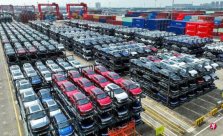
Chinese internal combustion engines have basically got rid of the image of the "cottage", and the development of new energy vehicles is obviously exerted, and its momentum is rapid.Chinese netizens vomited: I used to have no money and buy domestic production; now, there is no money to buy domestic production.
The second day of the 2024 New Year, the China Automobile Industry Association announced that the export volume of Chinese vehicle exports in the first 11 months of 2023 was 4.762 million units; according to data from the website of the Japanese Automobile Industry Association, Japan's export volume in the same period was only 3.99 millionVehicle.According to the Nikkei Asia, Japan is expected to export 4.3 million vehicles in 2023.In other words, this will be It has become the world's largest car export in the world.country.
Nowadays, not only the export of Chinese automobiles surpass Japan, but China ’s new energy vehicles are also obviously leading international peers in many aspects, including German -Japan -American car companies that have always dominated the development of the automotive industry.
Thinking of the topic reports I made in the development of China's automotive industry in 2014, sales of sales were topped by the independent brand list for three consecutive quarters.In the first half of 2014, the German Volkswagen sold more than 1.8 million vehicles in the Chinese market, while more than a hundred models of nearly 20 independent brand cars in China were sold for 1.368 million vehicles, and 20 independent brands could not reach a popular public.
Feng Shui turns.In 2023, Volkswagen sold 3.123 million vehicles in China and 30.24 million BYD. The BYD family alone could catch up with the public.
The industry experts in 2014 believed that Chinese car companies were still long.In 2023, China surpassed Japan and became the world's largest car exporter.China is the new force in the global automobile industry.
In 2014, China's new energy vehicle development has just begun. Although industry experts believe that the goal and direction of China's development of new energy vehicles is correct, it is not very optimistic.The leader of energy vehicles.
J.D. Power at the time of the automotive market survey agency at the time showed that the sales of new energy vehicles in the United States accounted for about 4%of the total vehicle sales, while China was less than 1%.Jundi predicts that by 2025, the sales of new energy vehicles in the United States will only increase to 6%to 7%, and China will only be 3%to 4%.
The research report released by the market research company MSCI in August 2023 Report the third energy revolution and the Chinese electric vehicle industry pointedUp to 25.6%.
Data proves that Chinese car companies are indeed overtaking.The tricks used in China are high -cost internal combustion engines, and new energy vehicles supported by large -scale input resources.
In the past few years, China's internal combustion engine car has made progress in design and technology. It has basically got rid of the image of the "cottage".The international market has a certain degree of support.
China's new energy vehicle development is obvious, and its momentum is rapid.
The Chinese government has invested in supporting new energy vehicles for the development of new energy vehicles a long time ago.Economist reports that China provides electric vehicle tax purchase discounts in the early 2010s. Local governments also provide various rewards and benefits to attract car companies to develop and produce electric vehicles in local factories.
These resources have created a number of new vehicles, such as ideal, Weilai, Xiaopeng, Zero Run, Ji Ji, Lantu, Aveta, etc. Now even Huawei and Xiaomi have also joined the battlefield.
Some new forces have invested their vision to the international market from the beginning. For example, Weilai has set up a modeling design center in Germany at the beginning, has a forward -looking technology research and development center in the UK, and has a software research and development center in the United States.Weilai, Xiaopeng and ideal electric vehicles have been sold to European countries.
Other brands such as BYD, SAIC MG (MG), Hezhong Nezha, GAC Ean, Changan Deep Blue, etc. have been put into production or sales in many countries in Southeast Asia.Recently, Geely's Ji and Smart also announced that they would enter the Singapore market.
China's economic growth and slowing consumption, overcapacity, and increasing competition in the electric vehicle market. New forces of vehicles are urgently needed to open up markets outside China.China New Energy Vehicle has led European and American peers in terms of technology, design, and cost -effectiveness. It has occupied markets with relatively low per capita income in Southeast Asia, America and even Africa as early as possible. They can first obtain market share in competitors.The development of similar electric vehicles in European and American and Japanese car companies has already lagged back China. It is likely to continue to fall behind in seizing the market. After all, the price of electric vehicles in traditional European and Japanese car companies is a lot higher than Chinese products.Consumers take out a lot of money to buy expensive electric vehicles.
Of course, the new forces of Chinese cars are not only low -priced products.BYD looks at the U8 listing price of nearly 1.1 million yuan (RMB, the same below, about S $ 200,000).Traditional luxury brands such as BMW and Audi.Chinese netizens talked: I used to have no money to buy domestic -made; now, there is no money to buy domestic production.




